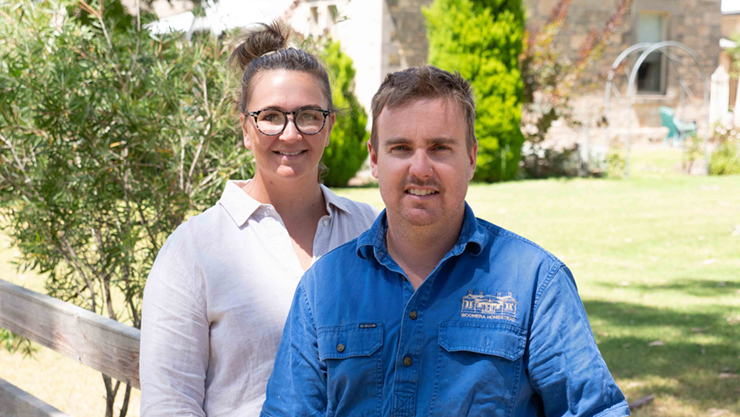 Penola sheep and cattle producer John Kidman, with his dogs outside a historical stone cottage which he had rebuilt next to his shearing shed.
Penola sheep and cattle producer John Kidman, with his dogs outside a historical stone cottage which he had rebuilt next to his shearing shed.
Farming in South Australia was tough in 2024, with rain failing to fall across most of the state until June.
Three SA producers, John Kidman, Nick Clarke and Todd Woodard welcomed MLA to their properties to share how they managed a very late seasonal break last autumn.
Participants at the upcoming Naracoorte MeatUp will be take a virtual farm tour across all three properties, where the producers will share how the challenges of 2024 have shaped their livestock and pasture management strategies for future tough seasons.
This article highlights the story of two of these producers and the changes they made to endure the difficult seasonal conditions.
Expertise in experience
Sheep and cattle producer John Kidman has been farming near Penola for 55 years. He can recall only three other seasons as tough as 2024, but he's always been prepared.
"We try to hold enough hay for the cattle for two seasons. That didn't hold us over last year, and we had to buy more hay," John said.
"When it hadn't rained by the end of May, we realised we had to take more action. To protect the land, we used containment feeding in the smallest paddocks we could and fed heavily."
Minimising productivity loss was a key priority.
"We try to maintain our average stocking rate, regardless of the season.
Our strategy was to feed through the dry season so we could carry on and have good production coming out the other side. We had a bigger grain bill than usual, but it was important to do."
John also aims to keep his Merinos and cattle at a condition score of three.
"To make decisions on production, I've used grazing charts. They're a very good predictor of what is coming. It comes back to knowing what a DSE (dry sheep equivalent) requires, and I adjust accordingly if an animal is pregnant or lactating."
While experience is valuable, John credits much of his improved practices to learning from others.
"We're going to have more of these seasons. It's great to be a part of a producer group to share experience and knowledge. The resources and information are available, you just have to get out there," John said.
"Our goal is to leave the property in a condition which is better than it is now. We'll achieve that through being involved and being proactive with what is happening in the industry."
Facing the feeding gap

South-east SA sheep and cattle producers Ellen and Nick Clarke, pictured at 'Woomera Homestead', Furner.
To the west, Nick and Ellen Clarke run a multigenerational prime lamb and beef operation near Furner.
Having recently taken over management from Nick's parents, 2024 was their first season leading the property through a very late seasonal break.
"We've experienced a lot of autumn feeding gaps in the past, which provided learning opportunities for everyone," Nick said.
Maintaining nutrition and condition scores for lambing was a key focus of their feeding budget.
"We use a local nutritionist in the area to make a feeding plan of what is available to feed and how much we'll need."
The Clarkes relied on a combination of their own hay and sileage, while supplementing with purchased grain.
"We fed all the way through lambing, and ran our feedlot at least double the capacity to a regular year.
"For our ewes, we fed an 80:20 barley and lupins ration, and learnt adding lime helped build strength," Nick said.
The tough season was an early but valuable lesson.
"Following 2024, this year we've futureproofed our place by keeping more feed on hand, planning to feed earlier in the season, and keeping a closer eye on the ewe condition score.
"We'll continue scanning the ewes to establish their needs and build our feed budget for the season and keep ewes off our lambing paddocks to get germination started for when the ewes start lambing.






